- Best STIHL Brush Cutter Replacement Blade - December 8, 2023
- Box Elder Wood Uses - September 30, 2022
- Hackberry Wood Uses - September 25, 2022
As the weather turns towards autumn and the chill in the air nudges you to plan your collection of firewood for the winter. The image of a winter evening fireplace filling the home with warmth is all the persuasion needed. It is time to stock up on your firewood.
Here I would like to take you through the process from harvesting the wood through to the relaxing evening in front of the fire. In this guide to firewood mastery, we will deal with all the steps along the way to make sure your firewood produces a clean fire of comforting warmth.
The essential element of an efficient fire is well-seasoned firewood and here is what you need to keep warm.
Let’s Have a Look at What Trees are Good for Firewood
Can we start with one golden rule, please? Can we fell our firewood in a sustainable way? Great. Let’s head out and make some decisions about what trees are best for firewood.
The first decision we need to make is what type of trees are we going to aim for. Hardwoods or softwoods. I’m hoping you have the choice because hardwoods are so much better at producing a good fire. If you are in an area that only has softwoods (trees with needle-like leaves) well, you are going to have to feed the fire a little more often.
Picture in your mind the perfect tree. Strong, straight, and, tall. Those are the trees that you don’t want to cut. Look for trees with defects. Trees that have split trunks, or are leaning over too far. Trees that are preventing light from reaching strong young trees are also in this category.
Trees that are dead seem to be the ideal type of trees to fell for firewood. Like all things that seem too good to be true so it is with dead trees. You may be lucky and get one that is dry and sound but there are many reasons why you should avoid dead trees.
Dead trees are worth far more to the natural environment than they are to your fireplace. They are both home and food sources to insects, birds, and mushrooms.
Felling trees is a dangerous business but felling dead trees is notching up the risks even more. Dead trees are unpredictable as the integrity of the wood is flawed. Dead branches are also waiting to remind you to wear a hard hat.Plan Your Harvest
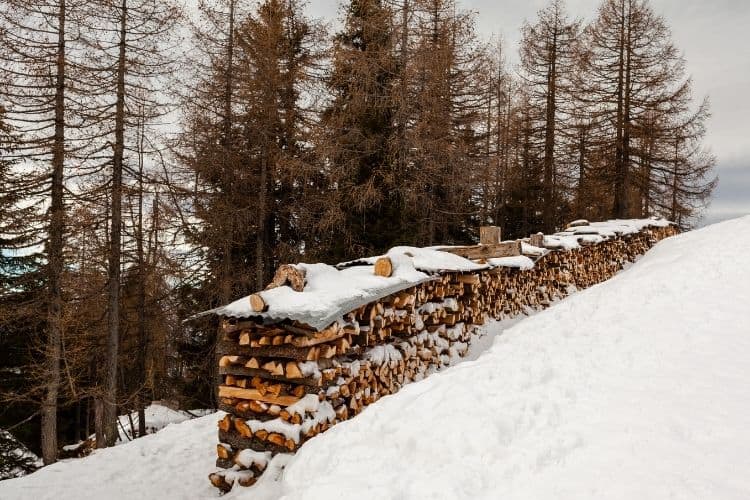
Spend a little time surveying your area. Plan your route for getting the felled timber to where you will be splitting and storing it. Plan so that the trees you fell this year will allow access to trees for next year. That will make your life a lot easier.
Remember as trees grow taller their canopies cover more area and reduce the amount of undergrowth. Areas, where trees have been cut down, will see a resurgence of undergrowth.
Read also: Best Firewood Covering Ideas.
Equipment You are Going to Need
The most important item is going to be a chainsaw. Together with the chainsaw is the essential safety equipment. Here we are dealing with the average collector of firewood for personal use and not the professional lumberjack.
I want to deal with the safety equipment first because it is the most important element. Everything except your health and safety is replaceable.
So let’s deal with the essential safety equipment. Firstly you are going to need a hard hat and visor. Often these are supplied as a single unit together with earmuffs. This is an essential piece of equipment and you are doing yourself a great disservice if you are thinking of using your chainsaw without your hardhat.
A good pair of boots are also pretty essential. Felling trees is going to result in the area around you filling up with cut-down branches and logs. You need good boots to keep you from tripping over these obstacles.
Gloves are another item that will save you medical costs. Felled trees have sharp edges, particularly around the hinge. Get used to controlling your chainsaw by wearing gloves.
Chaps and jackets are a good idea but they can be quite hot. I live in a subtropical climate and have been reluctant to use either but colder climates would make them more attractive. So dressed up in your safety equipment let’s have a look at what type of chainsaws are available.
Chainsaws so Many Choices
There are three types of chainsaws. Gas-powered, battery-powered, or corded. The latter is primarily a pruning type of garden tool so we will concentrate on the other two types.
Battery-powered saws have grown in popularity in recent times. They were once considered less powerful than their gas brothers but technology has given them a great boost.
As an indication have a look at the following Youtube contest between the two power sources.
So which one is good for you? Battery-powered chainsaws are relatively quiet. They are lighter and easier to handle than the gas-powered alternative. The lifespan of the chainsaw can be extended by carrying an additional battery. Most modern battery-powered chainsaws come with the backpack battery storage option for even longer operating times.
The really big advantage is that you can harvest wood at any time without annoying the neighbors. With fewer moving parts battery-powered chainsaws are easier to maintain and there are no starting problems. Flick the switch and you are in action. No tugging on a reluctant starter cord. No mixing gas and no exhaust fumes.
There is a wide range of battery-powered chainsaws available. Here are a couple of examples to help you decide.
With all these advantages why would you choose gas? There is a limit to the competitive edge of the battery-powered chainsaw. As we go up to higher power levels gas-powered chainsaws begin to predominate.
Where is the dividing line? You may well ask. Generally, as we go past the six to eight-inch diameter log and get into the more substantial log sizes the more powerful gas chainsaws win.
So how do you decide which one is for you? Have a good look at the trees you are going to source for firewood. Are they giant old trees with trunk diameters measured in feet rather than inches? If they are then gas is your bundle.
If however, you are in doubt I would strongly suggest persuading your local dealer to give you a demo of what the saw can handle. You may be surprised.
Power Comes at a Cost and it is not Only Money
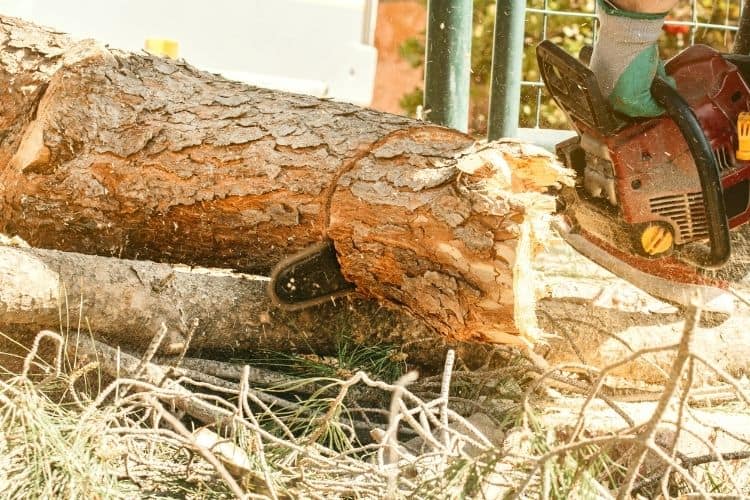
It is great to have a large and powerful chainsaw that can cut down a two feet diameter tree without hesitation. However, for firewood, most of the logs are going to be smaller than that.
So you will be spending much of the time holding up a saw bigger than required. Working a chainsaw is heavy on your arms. After an afternoon of cutting, you will feel as if your arms have been stretched by a couple of inches.
Take a good look at the average diameter of logs you will be cutting and then have a look at the range of chainsaws available from the more reputable brands.
Consider the balance here. I would rather spend an extra minute or two cutting through a big trunk of twenty-something inches than heaving a heavier than necessary chainsaw around all day.
Safety is another factor to consider. A kickback on a big machine is going to smack you very hard. On a smaller chainsaw, you will be able to control it a lot easier. Fatigue is the father of accidents and a heavy machine is going to sap your energy.
Here the guide is ‘size does count.’ So make it the right one for your requirements.
New Saw, New Safety Equipment. Time to Collect the Winter Fuel
Your bright and shiny hat matches the saw. Gloves and boots are feeling good and you have selected the first tree to cut.
Hopefully, you have gone through all the instructions regarding using the chainsaw and have filled the gas and chain oil tanks. Did you check the two-stroke oil to gas ratios? Both the chain oil and gas tanks should be full. They are designed to work together so always make sure that they are both filled before operating the saw.
Here is a little tip before you start. Check on the size of your fireplace or stove because that is going to be the correct size of logs you are going to need.
Before cutting down the tree you identified check how you want the tree to fall. Take your time and make sure you have an escape route if things go wrong. Falling trees can cause a significant amount of damage.
Have a look at this Youtube video that will take you through the process in detail.
There will come a time when you will experience the indignity of having your chain saw stuck in the trunk because the tree didn’t quite do what you thought it should. Getting the chainsaw pinched by the trunk or branch happens most frequently when crosscutting through fallen branches.
The fallen trunk remains supported by branches and as you cut through the trunk it sags and pinches the bar.
To avoid this identify which side of the piece you are cutting will be under compression. Cut about a third of the way through the piece from that side and then cut through the opposite side.
Splitting Wedges are always a useful accessory to have with you when felling trees. For further information use this link.
Getting from Logs to Firewood. How to Split Your Logs
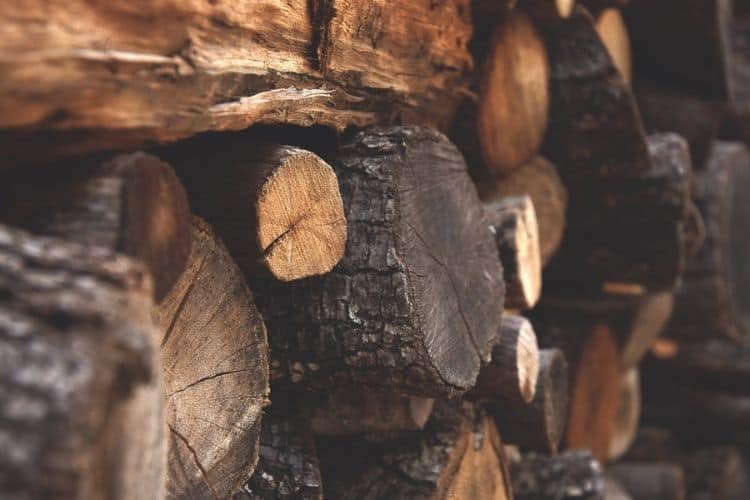
The tree is felled and the branches and trunk have been cut into neat logs of just about equal length. Did you remember to check on the size of your fireplace or stove? I hope so.
Now we need to convert the pile of logs into a neat split log stack. If you are going to split the logs on-site you will gain the advantage of better space utilization when transporting the load to your home.
On-site splitting means you are going to be splitting green timber. As a general rule deciduous trees are best split when green but conifers tend to split easier when seasoned.
There is another factor to consider and that is after a couple of hours of chainsawing your arms are not going to be in optimum condition for splitting logs. So load up the logs and take them home tomorrow will be a better day to split them.
There is the temptation to say. ‘Hey these logs will burn anyway so I’ll leave them in a pile and when they have seasoned enough I can just pop them in the stove or fireplace.’ Well, here are a couple of reasons why that would be a bad decision.
Leaving your logs lying in a pile on the ground is going to encourage rot and fungus invading the wood. Neither of which is going to result in a healthy fire.
Logs are going to take a whole lot longer to season than logs that have been split.
Stacking whole logs is going to take up a lot more room and is going to make the stack unstable.
For all these reasons it is better to split the logs and stack them in a neat pile.
There was a time when the credentials of a prospective husband relied heavily on the neatness of his firewood stack. Be prepared.
The classic pose of the lumberjack standing with his trusty ax next to a pile of split logs is a little misleading. Axes are meant for cutting down trunks. To split logs you are going to need a Maul. The difference between the two is that the ax is meant for cutting and the Mawl is designed to split. The Maul has a thicker wedge section and is blunt and heavier in comparison to the ax.
FTo some, the art of splitting timber is therapeutic and viewed as an invigorating form of exercise. If this is you, well done and I hope you enjoy many hours of happy splitting. There will come a time however when the thrill will wane and glances at power splitters will grow longer.
Power splitters take much of the stress out of splitting and are available in various sizes and power options. Electrically powered splitters are ideal for lighter operations. They have the advantage of being quiet as well as being able to be used indoors. They are limited to conventional power supplies.
Gas-powered splitters can be operated on-site. They are noisy however and can only be operated in well-ventilated areas.
Power splitters make the task of splitting firewood so much easier and safer.
Now that the logs have been split it is time to stack them. Correct stacking will produce several benefits. In particular, it will reduce the seasoning time of the wood and result in firewood that will burn cleaner with greater heat efficiency.
How to Stack Your Firewood
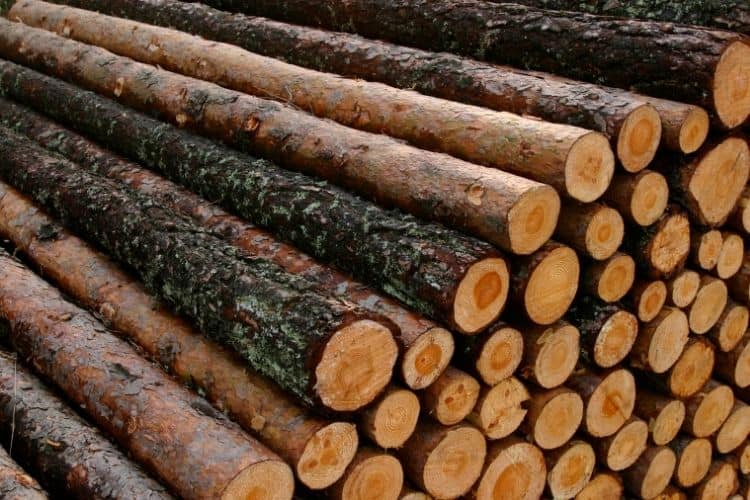
Stacking your firewood is aimed at allowing the wind and sun the best chance of getting your firewood moisture content down to the level that will produce a clean and hot fire. Here we are aiming at a moisture content of around twenty percent.
The hard work has been done and the logs are split. Let’s have a look at the various stacking options.
Stacking indoors is not a good decision. Although this does protect the firewood from rain and snow it also prevents the sun and wind from doing their job. Choosing the cellar as a place to store your firewood is not a good idea.
It means that all your firewood is going to have to be carried downstairs and then back up again when required. The humidity frequently found in cellars is not going to allow the firewood to dry.
Remember logs are a wonderful source of food to a wide variety of insects most of which you don’t want to invite into your home. This is particularly relevant if your firewood has been sourced from trees that were dead.
Chances are that insects were already happily settled down inside the wood before cutting down the tree and are now eager to venture forth into your home.
Keeping firewood outside is a far better option and don’t be tempted to make use of the garage. Firewood and flammable liquids are not going to endear you to your insurance broker.
As it is very difficult to burn rotten wood or wood that has been infected with fungus, the golden rule is to keep your firewood off the ground.
If you have been clever and kept your logs almost equal in length then the stacking is quite simple. Start with some horizontal supports that will keep the bottom layer of logs off the ground.
Stack the Individual Pieces
Stack the individual pieces so that the remaining bark on the pieces is facing up. Bark serves as a barrier to water entering the wood so keeping it facing up will reduce the ingress of water into your firewood from rain and snow.
It is important to align your stack in such a way that the sun reaches all parts of the stack and the wind can blow across the body of the pieces. The ends of each piece should be exposed to allow for maximum exposure to both wind and sun.
Stack the pieces in a single row and pack as tightly as possible to ensure that the stack is secure but still allows the wind to circulate around each piece.
If your logs were not cut to the same length do not despair. You can impress your neighbors by making a circular stack. This will allow for pieces of different lengths to be neatly stored in a circular pattern and you will also have an area where additional pieces can be stored.
There is a Place for the Traditional Woodshed
There is merit in protecting your precious firewood stack from rain and wind but slipping a cover over your stack is not the answer. A cover may well stop rain and snow from getting to your firewood but it will also stop the sun and the wind from doing their job.
At best a cover the same size as the stack will help but a woodshed that allows the wind to dry out the pieces and a roof that is higher than the top of the pile is going to be a much more efficient alternative.
A woodshed with a raised solid floor is going to deter the onset of rot and fungus and keep the bottom layers dry. If you are thinking about building a woodshed make sure that it is a fair distance from your house and don’t be tempted to stack your firewood against the wall of your home.
The Importance of Seasoning Your Firewood Correctly
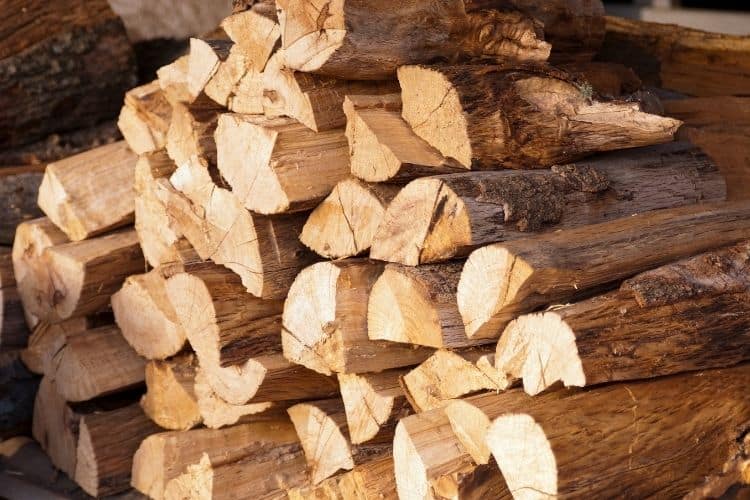
Moisture meters are fairly cheap and they do take a lot of the guesswork out of assessing the condition of the firewood. The twenty percent target is somewhat arbitrary but good to keep in mind.
No one is going to complain if your moisture meter indicates your firewood is twenty- two or three percent. You will, however, get anxious looks when smoke billows from the stove or fireplace, and the room does not seem to be getting any warmer.
Seasoned firewood not only produces higher temperatures but is also healthier and safer. Burning wet firewood results in harmful chemicals like creosote being released. This will clog up your chimney eventually and being inflammable, poses a serious fire risk.
There are a couple of ways to assess the dryness of your firewood. Firstly have a look at the color of the end of the piece. If there are cracks and the color is a dull grey then the wood is fairly dry.
Knock two pieces of firewood together and hopefully, the sound is clear and resonates. A dull sound indicates wet or rotten wood.
Dry firewood feels lighter than one would expect and if the bark has come away from the body of the piece then you are on the right track.
You can also impress your friends by assessing the dryness of the firewood by smell. Seasoned firewood has lost the distinctive smell of timber.
FAQs
Question: How Long does it Take to Season Firewood?
Answer: This is probably the most common question about firewood and sadly the answer is that it depends.
Firstly it depends on the type of wood that is being seasoned. Softwoods season faster than hardwoods but that is only half the answer. Woods like pine and willow are quick drying. Softwoods also burn faster than hardwoods so you are going to need a bigger supply of softwood to get you through the winter.
Apart from the type of wood, the length of the individual pieces also influences the drying time of the wood. The longer the piece of firewood the more time it will take to season.
For hardwoods, you are not going to get away with less than eight or nine months of seasoning. This is to a large degree determined by the prevailing weather conditions. Nature is always striving to create a balance so dry and arid conditions will hasten the drying time of the firewood.
Sadly the opposite is also true. Areas with high humidity have longer firewood seasoning times.
There are two rules that apply to the time it takes to season firewood.
Rule one is that it will take longer than expected and rule two is that your stack of firewood will not last as long as you expected. There are no exceptions.
Question: How Often does the Chainsaw Blade need to be Sharpened?
Answer: The answer to this question can be found in the shape of the chips that are produced when cutting. If the chips are large and well-shaped then the blade is good and sharp. As the blades become dull the sawdust produced gets to be smaller and less defined.
The chain will tend to heat up a little more and in extreme cases, the wood may begin to burn.
Chainsaws are often sold with sharpening kits and it is a simple matter to keep the individual blades sharp. Make sure that you have the correct diameter file for the type of chain you have.
t has been my experience that as a general rule I sharpen my blade every other time I fill my gas tank.
There have been times when cutting really tough timber that I have sharpened more often but use the shape of the chips produced while cutting as your guide.
A note of caution regarding the rivets on the chain. As the chain wears the rivets will come into contact with the bar. When this happens it is very important that the chain is replaced to avoid excessive wear on the bar and the danger of the chain breaking.
Question: What is the Best Wood for Firewood?
Answer: Firewood quality is assessed on the basis of a number of variables. The primary criterion is the heating potential of the wood. This is normally described as the Heat per cord. A cord of firewood is a stack of firewood four feet high and four feet wide and eight feet long.
The heat is measured in British Thermal Units (BTU) You can thrill your friends by telling them that a BTU is the amount of heat required to raise the temperature of a pound of water by one degree Fahrenheit.
Other factors that define the quality of the wood is the ease of splitting, the amount of sparks and smoke produced. The fragrance and the coals produced also are measured.
Have a look at the link below where most of the common woods are evaluated according to the criteria mentioned.
Firewood Mastery: Final Thoughts
So now we have completed our journey from forest to firewood and I hope that you have gained some valuable insights into the wonderful world of sustainable heating.
I would like to leave you with a final thought regarding safety. Chainsaws are dangerous and falling trees are deadly. It is so easy to become complacent and begin cutting without proper planning.
The risks of injury are raised even higher when there are a few people on site. Tell everyone around what you intend to do before you start. It will make things a lot safer.
Trees fall sometimes without warning and sometimes in directions that you had not planned.
You need to be err on the side of caution. Always.
I sincerely hope that, come winter you will be happily sitting with your feet up alongside a cozy fire enjoying the admiration of friends and family in your role as a true woodsman.
Congratulations.
Continue reading related Firewood guides:
